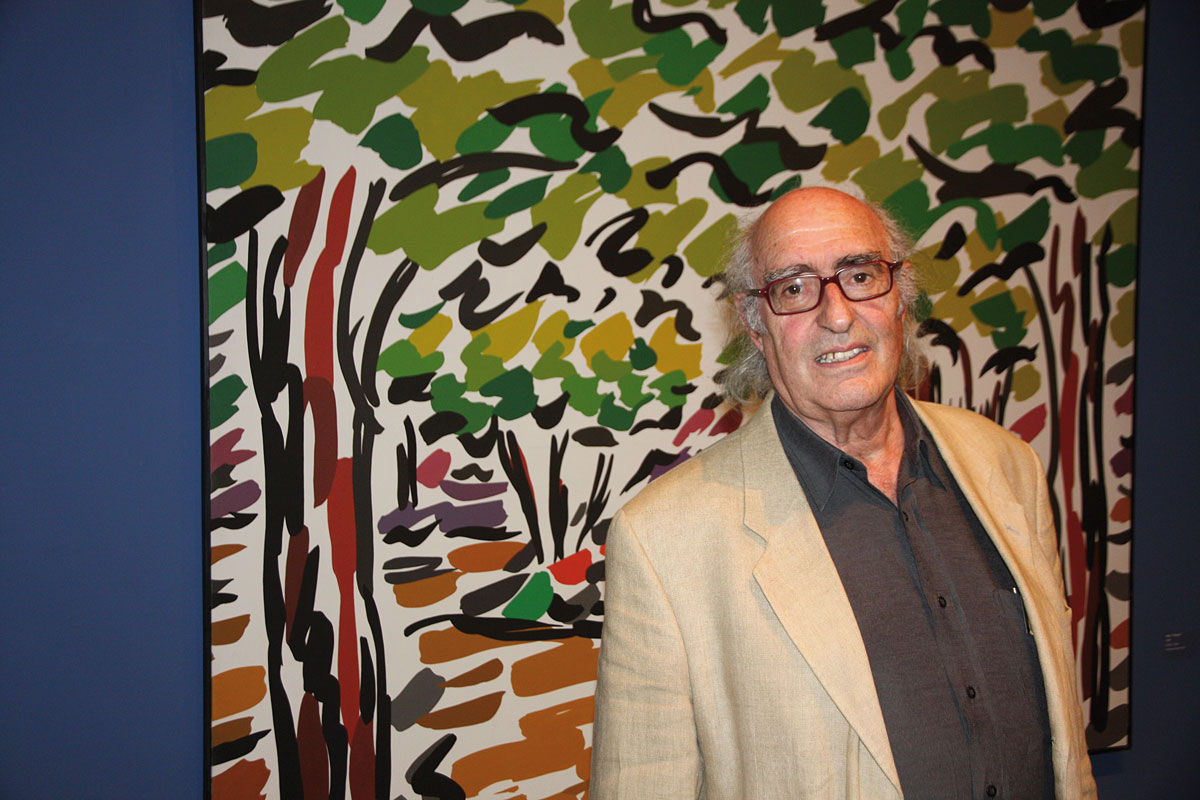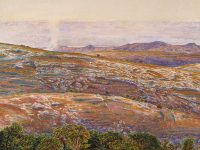Interview with Francesc Miralles
Historian and art critic
«Joaquim Mir the best landscapist in Spain»

Francesc Miralles Bofarull (Tarragona, 1940) is a historian from the University of Barcelona and an art critic. In addition, he is an expert on artist Joaquim Mir Trinxet, renowned representative of Catalan postmodern landscaping and author of La cala encantada (“The Enchanted Cove”, Mallorca, 1901 and 1902), the leitmotiv of this monograph of Mètode Journal. The art critic has written several works about the Catalan painter, like Joaquim Mir a Tarragona (“Joaquim Mir in Tarragona”, 1998), Joaquim Mir a Andorra (“Joaquim Mir in Andorra”, 2002) and Joaquim Mir a Vilanova (“Joaquim Mir in Vilanova”, 2006). Let us say that it is the person who knows the painter’s secrets best, maybe because of the complicity his father had with him. Tireless and full of vitality, Francesc Miralles arrives to the interview with unlaced shoes. Jovial, cheerful and mischievous, he claims to wear them like that on purpose: «I just want to contradict the grandmothers, to be a contrarian».
How would you define Joaquim Mir artistically?
To put it plainly: the best landscapist in Spain. To me he is the best landscapist in Spain’s art history.
Then, could we consider him the leading model of Catalan postmodernism?
It has also been said that he was impressionistic. But these subdivisions and classifications do not convince me much, I do not much like them. For instance, in the impressionist movement, what does Degas have to do with Monet? Or Renoir with Picasso? I understand artistic movements as groups of friends, but stylistically they are not very similar. What Mir does have in common with the impressionists is the direct capture of the landscape. Throughout history, the landscape has never been captured directly, it has always been done through notes and a later organisation of the landscape in the studio. However, the impressionists made paintings of direct landscape, like Mir.
So this relationship that Mir had with landscapes is what you would highlight the most of this artist?
Yes. This is a very important point, but other artists have already showed it. What I see in him that stands out the most is that he has had his own special and different way of looking at nature. That is what makes him a completely different and new artist. He saw colours where there were none… That means that he had a very special perception and vision of the landscape and of nature. He was the only one who had this vision of different colours, of knowing how to penetrate the amazing web of tonalities. A collector, a great admirer of Mir, was telling me the other day than one afternoon he counted sixteen shades of green in one of his pictures.
For an art critic of the time, Raimon Casellas, his paintings are «the gospel of intense light, the creed of solar paroxysm». Do you agree?
Yes, yes, yes! Of course! Raimon Casellas, the most advanced critic of the time in Catalonia, was very involved with impressionism. At that time, impressionism was prestigious in Europe, so Casellas wants to link Mir with impressionism, to make him very modern.
But then was Mir an impressionist? Can this painter actually fit into some defined artistic mold?
No. Casellas wants to make him pass for an impressionist. But Joaquim Mir is the same as artists like Anglada Camarasa, they are painters who have no disciples. There are painters who can forge a painting of his, but no one continues his work. Why? Because they are so personal, they have such a specific view of reality, that if you do not have this vision, you cannot paint like them.
You say he had no disciples, but who influenced him?
Mir was very self-taught. He is perhaps the only Spanish artist who did not go to Paris. He only moved through Catalonia, Mallorca, Andorra and travelled a couple of times to Valencia and Madrid. Which means that he did not have a lot of information on what is happening in the artistic world. This gives him a great value because he built his landscape and his interpretation of nature based on his way of life. He is not a painter who follows cubism, impressionism or surrealism. He follows nothing. He said he followed what he had inside.
With regards to his great work, La cala encantada, what feelings does it inspire in you whenever you see it?
The problem is that I have a very professional vision, I see it in a very technical way. Actually, I see Mir, who is exploding. La cala encantada is a great symphony of colours and images. The cove can be recognised, but if you look at it quickly you do not recognise it. Just when he was painting this picture, he said: «I have many things inside that will someday come out, and then you will see what I am capable of.» That is, here he did not consider himself a great artist, and that is what I see when I look at this painting. When I look at La cala encantada I see an explosion.
He painted it in 1901 in Mallorca and he painted several versions: one more figurative, another more abstract one, another more diluted one… How is it possible to paint such different styles in only a year?
As I said, in this moment Mir is still not Mir. Mir starts being Mir at that point. He still does not feel fully confident, he is starting to evolve, he still does not feel… It is an amazing painting. [He points to the bottom left corner of the most abstract version] If you look closely, this is an abstract fragment: you do not know if these are algae or rocks… he gradually distances himself from nature in order to abstract it.
It is said that he made his best works during his mental breakdown between 1902 and 1910, is that true?
To a certain extent it is true… It is true if we think that the works of that period are the most spectacular. As I said, this feeling Mir had inside comes out little by little and it is precisely in this moment when he makes a type of painting that is very different from everything that was done at the time. In these moments, he was practically abstract. He got ahead of the birth of abstraction with Kandinsky. Kandinsky is the first, but Mir, some years before, made some paintings that were completely abstract, because he was no longer interested in the landscape, he was only interested in light and colour. That is one of the reasons why he cannot have any disciples, because everyone looked for composition, while he did not care about that. A young apprentice artist told Mir that he wanted to paint a mountain in Vilanova i la Geltrú with Mir, who went with him and gave him advice. When the apprentice found the perspective he wanted to portray, he told Mir. He answered that he had to turn his back on the landscape, that he did not have to paint that, but only the light. That is why he almost reaches abstraction, because he gave no importance to the theme.
«When I look at ‘La cala encantada’, I see Mir, exploding. This painting is a great symphony of colour and images»
He was in the Reus asylum from 1904 to 1906. Why was he committed?
I am sure that Mir had some kind of extreme pathology. It is not exactly that he was insane. But it is said that one day while he was painting on an escarpment, in a very high part which got to the Pareis torrent in Mallorca, he tried to kill himself. Or he slipped, or he was pushed… There are some who say that he was with a girl from a village who already had a boyfriend and that some friends threw him over the edge… Nobody knows what happened and it has never been clarified. He was unconscious in the beach for a couple of days, practically dead. This fall heightened the bad mental state that he already had a little. Afterwards, he spent a couple of years in the asylum. However, he had the great luck of getting to the Reus asylum, where there was doctor Emili Briansó, who took very good care of him. They did not treat him with electroshock, which was commonplace at the time. He was saved thanks to this doctor.
Is it true that he saw colours where there were none?
That is an anecdote my father told me when I was little and I used it as the initial anecdote in my first book about Mir. During his stay in Aleixar (Tarragona), Joaquim Mir came to our family house. One day, out for a stroll with my father, he asked: «Papitu, do you not see those yellows on top of the mountain?» My father answered that he did not. And my father would say to me: «Of course he had to be committed in the asylum if he saw yellows where there were not!» This proves that Mir had a vision of the reflection of light that was completely different from everyone else’s. In Mir’s first great exhibition there was a very realistic painting of Andorra, and an acclaimed painter told me that he would be incapable of doing that in all his life. There were so many nuances, so many little contrasts and so many colours, that it was unique! The image of that mountain could be portrayed, but not like Mir, who was a genius.
«Joaquim Mir said that we did not have to paint the landscape, but only the light. That is why he almost reaches abstraction»
Did you decide to study the figure of Joaquim Mir because of the relationship your father had with the artist?
Yes. The president of the provincial government of Tarragona entrusted me with writing a book on Joaquim Mir. At the beginning I thought that I was in over my head because at first a writer was supposed to write it. But then I thought about my father. And I decided to pay homage to him. That is why the book starts with a sentence Mir said to my father, the sentence that I actually told you before. Then I spent time to fully study Mir because he is a very important and interesting person and, besides, there were almost no studies about him. Josep Pla also did a biography on Mir, he made him more than a man. Pla had met him, but he did not know him. He writes his legend. Thus, Mir becomes a Balzac character, a unique character. His biography is very amusing, but inaccurate and with many outlandish moments. He creates the image of a character. However, I have spent four or five years just studying Mir every day. He was the most independent figure in the artistic world of the time, he had barely any contact with any artistic group, save in his beginnings – as a fifteen or sixteen-year-old – when he joined up with Isidro Nonell, Santiago Rusiñol, Antoni Pitxot, etc. He always moved randomly.
Finally, do you believe that in order to be a genius, like Joaquim Mir was, one has to be a little insane?
Every artist has a special sensitivity. The greater they are, the more special, too. One does not have to be insane, but they do need to have this sensitivity. Look, from Mozart to Beethoven and from Vermeer to Van Gogh, all of them have this sensitivity I speak of. If that is not the case, one can be a good artist, but not a genius. I always differentiate between creators and artists, those who work in art and earn their living from it are the latter. There are many and very good creators, but they do not have that which makes them so magnificent. Between the two types, the most special ones are always the geniuses, those that stand out. These need to have a special sensitivity: seeing yellows where there are none, for instance.
He winks at me, sighs and finishes answering the last question point by point after going over Joaquim Mir’s long biographical journey. He says goodbye, but before standing up, and to my surprise, he ties the laces of his shoes.
Mir in the Tramuntana mountain rangeThe Tramuntana mountain range has an added value to its orographic-geologic importance, which marks the island of Mallorca: it was the great protagonist, with the spurs in the north, of the work of two painters who would shape the Mallorcan landscape and, at the same time, Spanish landscaping: Joaquim Mir y Hermen Anglada Camarasa. Joaquim Mir came to Mallorca in the beginning of the year 1900 and found in the rocky place near Pollensa a new and untamed theme to advance in the definition of his work and to provide new plastic and aesthetic contributions to the landscape. Hermen Anglada Camarasa took up residence in the Port of Pollensa in 1914; he had left Paris as one of the most important painters of the world; maybe the first. Throughout the years he gave us a lyrical vision of the northern coast of Mallorca and its flora. Somehow, he defined a good part of the subsequent Mallorcan landscaping. As far as Joaquim Mir is concerned, he painted La cala encantada in 1902. It was a commission. At the time, the Catalan industrialist Joan Palmer Miralles was building the Gran Hotel in Palma de Mallorca, considered the island’s first hotel. The architect was Lluís Domènech Montaner. The tenant, Antonio Albareda, commissioned the decoration of the great dining hall to Santiago Rusiñol – who was already famous and enjoying a long stay in his island of calm – and it was him who directed part of the commission – given its great magnitude – to young Mir. But he disappeared in the caves and cliffs near Pollensa, which greatly upset Rusiñol, who heard nothing from him or about how the three paintings were going, and he ended up deciding that if Mir did not deliver them before the agreed-upon date, he would paint them himself. But at that date Mir appeared with the three paintings ready, one of them one of the biggest landscapes of Catalan painting, with five metres of length. La cala encantada exemplifies the moment when Joaquim Mir started his path towards removing the theme, his preference for the chromatic value of the painting. In this spectacular work the realism – which the author would never abandon – begins to be diluted and he gives all the strength to colour. The impact that this work caused the day of the hotel’s opening was very strong, causing violent controversy among the traditional artists, as the press of the time notes. With this great oil painting – with the three works of the set – Mir is established as the most important landscapist in Spanish painting and Mallorca becomes a privileged centre of landscaping. Francesc Miralles. Art critic and historian. |





